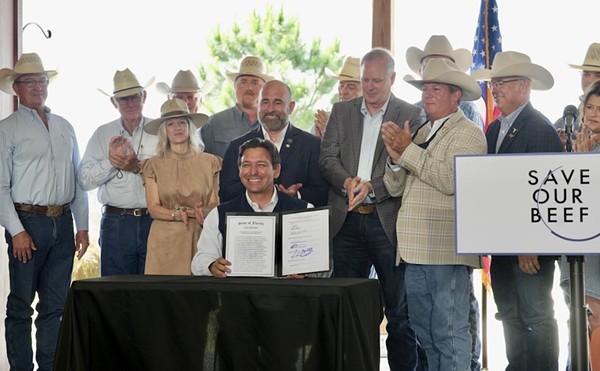I'm not the first to write about Henry Swanson, and I doubt I'll be the last. His home, in an upscale retirement duplex in Winter Park, is littered with faded, yellowed newspaper clippings, award plaques and personalized letters from governors and state department heads. He even has both an Orange County office and a state law named after him.
One writer compared Swanson, 77, to the biblical prophet Jeremiah, "the voice crying in the wilderness" whose message was ignored. Another listed him among the 10 most influential people in Orange County history. His friends describe him as a "legend," a "drum-beater" and someone "years ahead of his time."
And they're right. In the 1960s, the then-county agricultural extension director was one of the two so-called "Disney doubters" -- the other was Commissioner Paul Pickett -- who warned the giddy Chamber of Commerce that Disney World's insurgence into Central Florida would harm the area's natural resources as much as it would benefit the then-agriculturally dominated economy.
Few listened, and Orlando embraced the Mouse with open arms. But Swanson was on target. The ensuing population boom, now more than 1 million, has eaten up the area's water supply, to the point where the St. Johns River Water Management District expects demand to outpace need within 20 years unless a new supply is found.
In the 23 years since his retirement, Swanson's become obsessed with what he considers his God-appointed mission: Convincing local lawmakers to preserve high-recharge lands, which allow rainfall to seep down into the Floridan aquifer, the source for most of Central Florida's drinking water.
The more concrete that is poured, Swanson says, the more rainfall will evaporate before it has a chance to seep underground. And with the population still skyrocketing, Swanson sees a dangerous mix.
Though his Disney-era predictions came true, his recharge-preservation efforts have yet to catch steam -- and for that, he blames environmentalists. Their laserlike focus on protecting wetlands, he says, has distracted politicians from saving areas that he thinks should be the No.1 priority.
"Every day," he says, "the `recharge` land is being bought up. We're at a point of no return."
"Recharge" is hardly a hot-button word. In fact, development in West Orange County, home to most of the area's best aquifer recharge zones, is fast and furious. Old citrus farms have given way to quick growth in Ocoee, Winter Garden and Windermere even as Horizons West, a planned 38,000-acre mega-community with tens of thousands of homes and apartments, dozens of schools and a massive town center, moves closer to reality.
Despite that growth, the county commissioner who represents West Orange, Teresa Jacobs, has hardly heard a peep about recharge. She can recall only one or two people even mentioning it to her in connection with Horizons West (which already was approved before she was elected).
"If it was a pressing issue," she says, "I'd find it hard to believe `nobody brought it up`." Her conclusion: It's not a pressing issue.
That, Swanson counters, is because people don't know recharge's importance. In fact, what was arguably the most comprehensive study on Orange County's recharge zones -- a 1968 U.S. Geological Survey (USGS) report titled "Investigations No. 50" -- isn't even on hand locally; when asked, the county was able to locate a copy only in Tallahassee.
Its findings are significant: Ninety-five percent of Orange County's drinking water, the report says, comes from rain that falls within the county borders and then percolates down into the underground water table. Of that, 80 percent comes from the high recharge areas in West Orange. Combined with a bit of groundwater obtained from neighboring Lake County's recharge zones, that rainfall supplies drinking water to communities from here to the Atlantic coast.
Yet as the current three-year drought brings increased lawn-watering restrictions, the idea of preserving those recharge areas is still Swanson's alone. Even when the rains return, he says, the area's water problems will only get worse.
"It's like watching a man die of cancer," Swanson says. "You start to see signs of him expiring."
Swanson stepped onto the public stage after assuming the job of agricultural extension director in 1957, the same year the U.S. Department of Agriculture asked for a report detailing, among other things, available water and population expectations for 1975. This was a few years pre-Disney, but the writing was on the wall.
In the late 1950s, the Martin Marietta Co. bought a patch of citrus land for $200 an acre on South Orange Blossom Trail, a windfall for the landowner, who Swanson says had bought the land during the Depression. "The message," Swanson says, "was that the era of selling land based on its agricultural potential was over. Now it's sold on its real-estate potential."
In other words, the area's farmers realized it was time to make some big bucks. In the '60s, major highways followed industry, and before long, Central Florida had a naval base, a university, a community college and an airport.
Disney was, in essence, the two-ton straw that broke the camel's back. On Nov. 15, 1965, when Walt Disney announced his intentions, Swanson knew Orlando's days as a citrus town were gone. He fired off a letter to his counterpart in Anaheim, Calif., where Disneyland was then just 10 years old, who replied that while the theme-park certainly would stimulate the economy, he should expect some growing pains.
Swanson immediately began raising red flags. "Disney World," he told the Rollins College student newspaper just months before the resort opened in 1971, "is an A-bomb ticking to go off."
"Swanson," the article went on, "is most concerned about the dwindling water supply." The Mouse would cause neighboring citrus properties' values to skyrocket, and growers would sell to developers who would then pave over the water recharge areas. If nothing was done to stop the impending growth, Swanson said then, Florida would have to rely on treated wastewater being funneled back into the aquifer -- something that's happening now.
"`Swanson` warned us what would happen if we paved over everything," fellow "doubter" Pickett, now deceased, told a reporter in 1984. Indeed, Swanson is in part credited with helping to shape the county's first planning and zoning laws; until then, development was pretty much a free-for-all -- a war with landowners that he detailed in his 1975 book, Countdown for Agriculture.
Despite his contrarian views, few county leaders blinked as Disney made over Orlando into the tourist capital of the world.
He was right about `his` dire predictions," former Orlando Mayor Carl Langford said shortly after Swanson's retirement. "But nobody listened to him."
"`Swanson's` more than a guy," says longtime friend Dave Crowson, who once headed the Orlando Utilities Commission's water division. "He's a damn legend."
I first spoke with the "legend" a few days after Orlando Weekly published an article on the debate about Gov. Bush's controversial aquifer storage and retrieval (ASR) plan, which environmentalists and the U.S. Environmental Protection Agency both warned could contaminate the aquifer. Swanson tracked down my home phone number and called a little before 9 a.m., waking me with an hour-and-a-half discourse on the history of Florida water politics.
For Swanson, that's not at all unusual. "If you woke Henry Swanson at 3 in the morning," says William F. Lichtler, who was the team leader for the USGS's 1968 report, "he'd be giving a speech before his feet hit the floor."
Indeed, it's rare to have a conversation with Swanson that lasts less then 45 minutes. In part, he's just gabby; he'll get caught in a tangent and find it hard to reel himself in. But mostly he's obsessed. Water isn't merely Swanson's hobby -- it's his crusade.
Or, as he terms it, a way of paying his "civic rent." While others may teach Sunday school or volunteer at a soup kitchen, Swanson says talking about recharge is his way of helping future generations.
After years on the Rotary Club circuit, where the area's power brokers would applaud him but never take his advice to heart, Swanson decided to take his conservationist tone to Tallahassee. In 1980, he ran a contributions-free campaign, and to many political observers' surprise, he won the Democratic primary. Still, running against the "Reagan revolution" proved too overwhelming, as Swanson was stopped by Republican Daniel Webster, now a powerful state senator.
Undeterred, Swanson immediately began pushing his "Bluebelt Act," intended to give tax breaks to landowners who refused to develop their high-recharge acreage. It would occupy the next 17 years of his life."
"Mine was a delaying tactic," says Swanson. "`It would` encourage people to stay there `on undeveloped lands` as long as possible. The only other alternative was to buy the land," and that was prohibitively expensive.
Year after year, however, his bill died of neglect in the Florida Legislature. Finally, in 1987 a frustrated Swanson pulled his one trump card -- state Rep. Sam Bell, an old acquaintance who headed the House Finance Committee. Swanson sent Bell a "picture letter," an eye-catching correspondence where words like "I" are substituted by a magazine clipping of an eye, begging for help. He got it.
Bell rammed the bill through both houses, and Swanson thought he'd won. Not so -- to enact the Bluebelt law would require a change in the state constitution. So in 1988, it appeared on the ballot, and passed by a two-thirds majority. The new amendment went back to the Legislature, and the wait continued.
A 16-member panel traveled the state, charged with taking community input for implementing the law. The panel finished its survey shortly before the 1992 legislative session began, but four years passed before the law actually went into effect -- and by then, Swanson says, it was too watered down to have much impact.
For one, lawmakers required it to be enacted on a county-by-county level; two, the tax-break recipients had to agree to keep their lands free of development for 10 years or face a fine. (That requirement later was knocked down to five years, still too long in Swanson's view).
In 1997, Orange County became the first county to implement Bluebelt -- and, eventually, the only county. Despite the support from the state's voters, no other jurisdiction put the law on their books. In the end, the only thing that Swanson's work on the issue earned him was a plaque presented by then-Orange County Chairman Linda Chapin.
When Swanson dives into something, he goes full steam. Just take butterflies.
On a July afternoon in 1976, Swanson noticed a small butterfly landing on his 2-year-old grandson's head. He laughed it off, but when he saw an identical butterfly in the same backyard almost a year later, he became curious. Swanson recalls it as a bit of an epiphany -- he'd discovered something that, like water, would consume much of his energy for the next 25 years.
It wasn't the same butterfly -- butterflies don't live that long. And the twin butterflies weren't merely attracted to flowers, as the common perception suggests, because Swanson's yard didn't have any flowers. He watched, and realized this species visited his backyard around the same time every afternoon. While riding his bike around his neighborhood, he noticed they did the same elsewhere.
Butterflies, Swanson concludes, are like salmon. They instinctively return to their birthplace to mate. "They stake out a territory," he says, chuckling a bit. "My backyard happened to be a territory."
About every two weeks, he says, one male will try and usurp another's "harem," the spot where females come to mate. Now that he knows it happens, he says, the key is trying to figure out why. "I'm trying to break the butterfly code," he says.
Meantime, he's already written a book, "20 years of Butterfly Revelations," the proceeds of which benefit his church's college fund. He's now having his work evaluated by experts for possible recognition. Maybe, he half-jokes, a Nobel Prize.
Swanson attributes his near-obsessive work ethic to his childhood -- specifically, to the way his father favored his older brother. Playing "second fiddle," he says, "you sort of either get an inferiority complex or you run scared. I wanted to be the best I can. It was a motivational thing. I like to be on the cutting edge."
In high school, Swanson was on the cutting edge of polka, of all things. As a member of the Eustis 4-H Club, he and some buddies won the state polka competition, and headed up to Chicago for nationals. There, Swanson found his life's calling.
Though his polka team came up short -- fourth place -- Swanson watched how the county's agricultural agents interacted with the kids, and decided that's what he wanted to do. His 1941 yearbook lists "county agriculture agent" as his future occupation. And, he says, he always wanted to work in Orlando.
By 1954, following marriage and two children, a brief stint in the Navy and a master's degree from the University of Florida, Swanson got his wish, and joined Orange County's agricultural office. Three years later, he became its top agent.
In 1960, when the USGS's Lichtler began his eight-year water study, Swanson was there, constantly looking over his shoulder. Indeed, Lichtler today recalls him as a bit of a busybody who ate up the information and picked Lichtler's brain for all the technical issues.
When Lichtler moved on, Swanson assumed his rallying cry, beginning his quest to preserve Orange County's water. "My mission," he says, "was to say that people were coming. I couldn't make policy; all I could do was be an `educator`. It was my responsibility."
At times, Swanson admits, that responsibility has grown tiresome, especially when his advice and proposals are consistently put on the back burner. In 1985, he told a reporter he had "battle fatigue."
Sixteen years later, the water warrior says, "I ain't gonna break this water thing. I want to flush it out of my system and be done with it. It's time to quit. I've rattled the cage long enough."
But as Swanson bows out, state officials may be ready to pay attention -- thanks to the drought. Recently, the St. Johns River Water Management District committed $250,000 to study the impact of development on recharge lands and the related effect on the aquifer -- something that has never before been done.
Currently, says the water district's Barbara Vergara, the state requires that development not affect either the quantity or quality of stormwater runoff -- which basically means that retention ponds must be included in any development plans. Right now, she says, the evidence indicates that that's enough.
But, Swanson argues, as more concrete is laid, the longer rainwater sits above-ground before heading into the aquifer and, consequently, the more it is allowed to evaporate. It's the same argument he's made for two decades, and finally, Vergara concedes, he's getting a response. In fact, she credits the new study to Swanson's constant bell-ringing.
"We recognized the need for an aquifer protection plan," she says. "He may be right. That's exactly why we're doing this."
Recently, Swanson backed an Audubon Society-supported measure tying the approval of new developments to the availability of water supply. But it was introduced late in the legislative session and died. Vergara says the St. Johns district, along with the state's other four water districts, will examine the proposal before deciding whether to back it next year when it's reintroduced.
In the meantime, given that demand will overwhelm the water supply in about 20 years, the state is looking for alternative supplies. The most notorious proposal is the ASR bill. Backed by the water districts but killed in the recent legislative session by public outcry, ASR would have let utility companies pump contaminated water into underground bubbles for storage, then pull the water up and treat it for use. (In contrast, the federal Clean Water Act and state law currently require that the water be treated to drinking standards on both ends.) Hoping to head off a second try, environmental groups now are considering a constitutional ban on injecting untreated water into the ground.
Under the current standard, the district is also evaluating an ASR plan that, along with Seminole and Volusia counties, would store water pulled from the St. Johns River. And it's looking to reclaimed water -- something Swanson predicted 30 years ago -- to pump into high-filtration areas such as West Orange.
If nothing is done, Swanson warns that Central Florida may be headed for the same kind of lawsuit-ridden "water wars" that have plagued the Tampa Bay area for almost a century. There, sprawling Pinellas County went water-bankrupt a century ago (much of its underground water table contains too much salt for consumption), and began tapping the sparsely populated Hillsborough and Pasco counties for water. When those counties filled up too, the battle for a limited water supply was on.
In the 1970s, the Legislature jumped in, creating an authority to prevent the petty county infighting and look at water issues regionally. It was weak and ineffective, so 20 years later lawmakers tried again, establishing Tampa Bay Water. It's solution: a $100 million desalinization plant, which would remove salt from brackish gulf waters and treat it to drinking-water standards. Environmental groups, however, are suing to stop the plant, saying that the tons of salt brine pumped back into the gulf would alter the water's salinity and kill sealife.
In Central Florida, where Orange County is running low, the Brevard County municipality of Cocoa has 48 active wells operating within Orange County's borders, tapping about 28 million gallons of water per day. (Cocoa, which supplies most of the Space Coast including Cape Canaveral, has contracted for wells inside Orange County since the 1950s.) The reason: Like Tampa Bay, the more water pulled up near the coastline, the more salty the water table becomes, forcing wells further inland.
Swanson's concern is legitimate, says Vergara, of the St. Johns water district. "We're very concerned about the potential legal conflicts," she says. "We want to lay out a process to encourage major users to work together to come up with `regional` plans."
Swanson puts it more succinctly: "We're dancing on the head of a pin, and we don't even know it."
Because Swanson's been so influential in forming the county's growth policy, he's almost universally admired by environmentalists. Until, that is, he starts talking about wetlands. Simply put, he thinks it's politically easier to protect beautiful areas of animal habitat than to save the sight-unseen aquifer.
Since environmentalists don't worry about it, he says, the media don't either. And neither do politicians. So when Swanson sees the state paying millions to preserve the Green Swamp -- 322,690 acres of swampland in Polk and Lake counties that, for the most part, can't be developed anyway because of state and local rules -- or restore Lake Apopka while recharge lands continue to be freely developed, he sees misguided priorities.
"The No. 1 priority," he repeatedly insists, "is drinking water. Everything else is secondary." Indeed, there are no regulations for recharge-development like there are for wetlands, where everything is carefully examined.
"I agree `there should be protections for recharge lands`," says Don Boniol of the St. Johns district's groundwater division. "But those are the areas that are best for development. That's more political than I want to deal with."
While Swanson doesn't consider himself anti-wetlands, his unconventional conservationism has raised eyebrows, particularly among the Friends of the Green Swamp group.
"This guy's got the wrong kind of focus," says the group's John Ryan. While the swamp may not be as valuable for recharge purposes, it does "prime the pump" -- keeping pressure on the water table to force its flow east. It's also the headwaters for four major rivers and provides pristine animal habitat. Moreover according to a recent St. Petersburg Times report, some hydrologists now draw a link between the drought and development near wetlands. The less water is stored, they theorize, the less evaporates and is returned in rain.
"Off the top of my head," says Cluny McCaffrey, of The Nature Conservancy (TNC), "I can't think of a group that's working on uplands because it's in a recharge area."
TNC and other environmental groups, however, do work to protect scrub habitat and pine forests, which often lie on upland recharge lands. McCaffrey concedes, though, the general public knows a lot more about wetlands than about recharge. But with the drought, that may be changing.
Still, Swanson says, the wetlands emphasis is too great. "We have a lot of the blind leading the blind," he says. "They've gone with this statement `that the Green Swamp is a key hydrological asset` like the flat-worlders."
Like her husband, Billie Swanson seems to have a crystal ball. The first time she saw Henry, then employed by her father as a lifeguard, she told her sister she would marry him. Fifty-seven years, two kids, four grandkids and two great-grandchildren later, she calls her husband "the greatest man I've ever known."
Swanson gets the same accolades from his political opponents. Orange County Commissioner Ted Edwards, who opposed Swanson's Bluebelt tax breaks, says, "We'd be a much better community if there were more Henry Swansons."
Edwards, who receives at least one handwritten letter every month from Swanson, agrees that wetlands have diverted too much attention from recharge lands. He believed, however, that the Bluebelt law was impractical.
"I can't think of a gentler soul," says Linda Chapin, who met Swanson 30 years ago when he spoke at a League of Women Voters meeting. "Though, heaven knows, he can fight for what he believes in."
Frustration has tempered that fight -- but only slightly.
"We're going to hell in a handbasket," he says as I leave him on a humid Monday afternoon, "and I don't see how you can turn it around. Everyone's gonna see the showers we've had lately and breathe a little easier, but `they're` being lulled into false security."
Swanson pauses, takes a deep breath and flashes a warm, weathered smile. "I got to learn to relax and say, ‘I did the best I could."
















